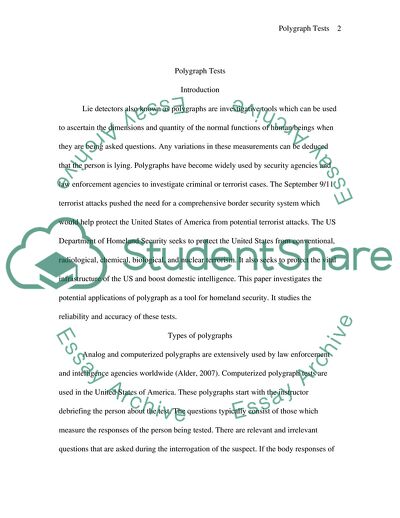
- Home
- Free Samples
- Premium Essays
- Editing Services
- Extra Tools
- Essay Writing Help
- About Us
- Studentshare
- Subjects
- Miscellaneous
- The Utility of Polygraph as it Relates to Homeland Security
The Utility of Polygraph as it Relates to Homeland Security - Essay Example

- Subject: Miscellaneous
- Type: Essay
- Level: Undergraduate
- Pages: 4 (1000 words)
- Downloads: 0
- Author: alessandra16
Extract of sample "The Utility of Polygraph as it Relates to Homeland Security"
The US Department of Homeland Security seeks to protect the United States from conventional, radiological, chemical, biological, and nuclear terrorism. It also seeks to protect the vital infrastructure of the US and boost domestic intelligence. This paper investigates the potential applications of polygraph as a tool for homeland security. It studies the reliability and accuracy of these tests. Analog and computerized polygraphs are extensively used by law enforcement and intelligence agencies worldwide (Alder, 2007).
Computerized polygraph tests are used in the United States of America. These polygraphs start with the instructor debriefing the person about the test. The questions typically consist of those which measure the responses of the person being tested. There are relevant and irrelevant questions that are asked during the interrogation of the suspect. If the body responses of the person are normal this means that the person has passed the test. In the absence of such a scenario, the person is forced to admit that he or she is lying.
The American Polygraph Association considers the polygraph to be highly accurate and reliable tools. They believe that an estimated four hundred studies have been conducted in the past two decades which testify as to the accuracy and reliability of polygraphs (Sullivan, 2008). Computerized polygraph systems are considered to be more accurate and reliable as compared with analog polygraph tests. They respond to criticism of these tests by insisting that any faults or shortcomings of the test are because of the examiner rather than the techniques.
Some critics say that the test is not accurate because the examiner can intimidate or frighten the test subject. This would result in emotional anxiety to the test subject which could be miscalculated that the person is lying. Polygraphs can be a vital tool for homeland security officials in defending the borders and entry points of the United States of
...Download file to see next pages Read MoreCHECK THESE SAMPLES OF The Utility of Polygraph as it Relates to Homeland Security
Polygraph Testing
Polygraph Testing as a Chief Method of Ensuring National Security
Economy and Infrastructure Sector
State of Emergency in Florida
Should Polygraph Tests be Admissible at Trial as Valid Scientific Evidence
The Utility of Polygraphs in National Security
The Utility of Polygraph as an Investigative Tool in National Security
Taxonomy of Counter Intelligence Threats and Risk Based on ISO31000

- TERMS & CONDITIONS
- PRIVACY POLICY
- COOKIES POLICY